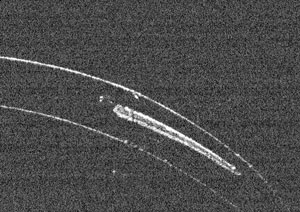 |
Alternatively, what if patients only had to put contact lenses in to deliver their daily glaucoma medication? Results of a study recently published in Ophthalmology suggest this could be the future of glaucoma management.
Investigators from Massachusetts Eye and Ear Infirmary encapsulated a latanoprost-polymer film into a hydrogel lens to create latanoprost-eluting low-dose (97g) and high-dose (149g) contact lenses—CLLO and ClHI. They then studied the effects of these lenses in glaucomatous eyes of four cynamolgus monkeys (induced by argon laser trabeculoplasty) and compared it with treatment using traditional 0.005% latanoprost ophthalmic solution.
 |
| To create the sustained medication delivery system, researchers added a thin latanoprost-polymer film within the periphery of a methafilcon hydrogel, which was then lathed into a contact lens. Photo: Amy Ross and Lokendra Bengani, Massachusetts Eye & Ear. |
The low-dose CL was worn continuously for seven days, followed by a three-week hiatus in treatment as a washout period. Topical treatment was then administered for another five days, followed by another three-week break. Finally, the high-dose CL was worn continuously for seven days. The study was powered to only detect large differences in IOP reduction between treatment groups.
IOP measurements performed with a pneumatonometer before, during and after treatment revealed the sustained delivery of medication was at least as effective as the use of daily latanoprost ophthalmic solution, and at some time points showed a statistically significant difference in reduction. For example, CLHI reduced IOP by as much as 34% on day three, compared to the 10% seen with the topical treatment. On the last day the difference was 32% vs. 21%. Researchers were surprised by this finding in particular, given that topical 0.005% latanoprost ophthalmic solution is considered the optimal treatment option for IOP reduction.
In addition, the latanoprost-eluting contact lenses provided relatively steady IOP reduction throughout the study—a key difference from topical treatment, which resulted in more variation in IOP reduction during diurnal measurements. For example, CLHI lowered IOP by -10.5±1.4mm HG on day three, -11.1±4mm Hg on day five and -10.0±2.5mm Hg on day eight. In contrast, treatment with daily eye drops on the fifth day showed a reduction of -3.0±0.4mm Hg before drop instillation, a peak of -6.5±0.6mm Hg two hours later and then a decrease to 3.5±0.3mm Hg four hours after that.
More to Come
Constant therapeutic effect, as seen with the drug-eluting contact lenses, could have significant impact on treatment for patients with glaucoma. This study comes with limitations, however, including the small sample size and minimal ocular safety assessment.
More research is needed to determine the optimal continuous-release dose that would be well tolerated by patients and provide maximally effective, the researchers conclude.
Ciolino JB, Ross AE, Tulsan R, et al. Latanoprost-eluting contact lenses in glaucomatous monkeys. Ophthalmology. 2016 Oct;123(10):2085-92. Epub 2016 Aug 29.

